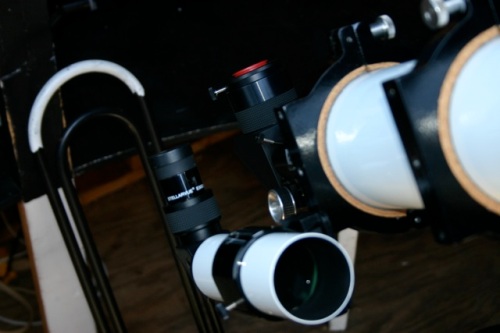OK, what really works is small aperture and low power – that is, I was once more successful with that combination while observing from the warmth and comfort of my library through sliding glass doors with the typical double-thickness, insulated glass in them. I was using the 50mm (205mm focal length) Sparrow Hawk from Stellarvue and some very simple, ridiculously inexpensive, eyepieces from Burgess. What was I able to see:
- M13, the beautiful globular cluster in Hercules
- Nu Draconis, a wonderfully matched pair of fifth magnitude stars that can just barely be split with hand-held binoculars.
Mind you – through these doors I have a very small section of sky open to me because of nearby trees. But I thought about going out to observe, however it was after 5 am, the temperatures was 27 degrees, it was windy, and there was a foot of snow on the ground. With dawn not far off it just didn’t seem worth the discomfort. Then I thought of the little telescope, sitting on its cheapy tripod in the same room. I placed it near the doors, put a chair behind it, and immediately picked out M13 in the 23mm eyepiece (9X). Wow! That was easy. So I zoomed in on it and it’s two bracketing stars with the 12.5mm Symetrical. This yields about 16X and the most pleasing view. But I pumped it up with a 6mm Symetrical to about 34X. Now don’t get me wrong. I could not resolve the stars of the cluster. But even at the lowest power it was obvious what I was looking at and the essential experience of the cluster is available at 16X. The little scope won’t handle well anything much higher than 34X and I doubt that the conditions – observing from a heated room through a closed, sliding glass door – would allow much more magnification.
Nu Draconis was also in view, so I swung over to it. Again, at 9X I could just split it, at 16X the view was very pleasing, and 34X didn’t really enhance it much aesthetically.
Still, the bottom line is this. You can have a nice, meaningful astronomical experience with a small telescope and low power while staying warm and cozy in your home.
BTW – I have been out in the Observatory several nigths and mornings since the blizzard hit last weekend. On these occasions the temperature has been lower and the conditions generally poor – but at least it wasn’t close to dawn. My endurance allows only 60-90 minutes of outdoor observing, though, once temperatures fall below 20. So I’m a farc ry from opting for indoor observing. But it’s fun to see just how much I really can enjoy with such a small scope without going out and challenging the cold.

